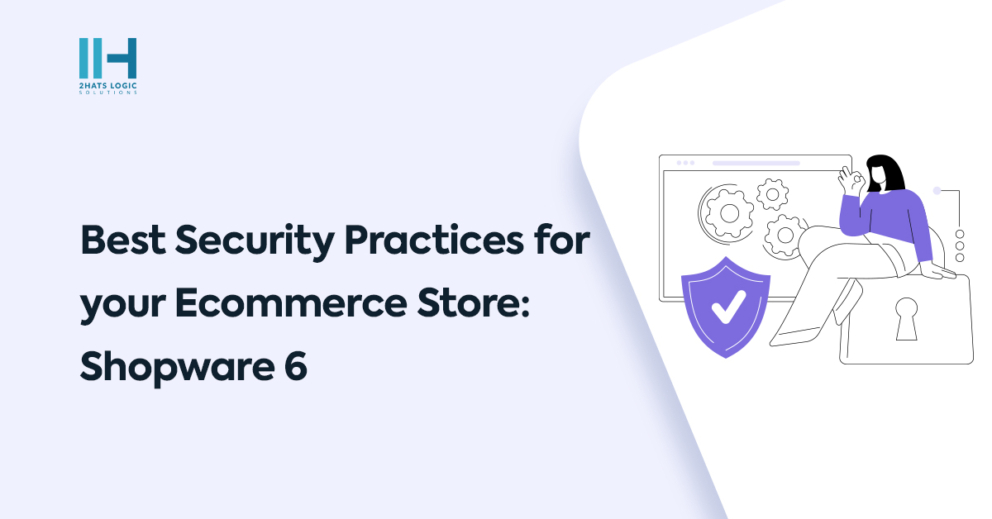Greetings! I'm Aneesh Sreedharan, CEO of 2Hats Logic Solutions. At 2Hats Logic Solutions, we are dedicated to providing technical expertise and resolving your concerns in the world of technology. Our blog page serves as a resource where we share insights and experiences, offering valuable perspectives on your queries.

In today’s digital world, security is one of the most crucial factors for online businesses. A single security breach can have major consequences, resulting in financial losses, legal issues, and irreparable damage to customer trust.
As evidenced by the 2022 data breach that exposed the personal information of over a billion Chinese citizens, Alibaba, one of the world’s largest e-commerce companies, was not immune to these threats.
This incident serves as a stark reminder that no business, regardless of its size or reputation, is vulnerable to cyberattacks. Online businesses need to adopt robust security measures to protect their customers’ data and safeguard their operations. In this article, we will explore some of the best practices to safeguard your Shopware store, including how to handle a security breach and protect it from potential security issues.
Essential Security Practices for Shopware Store
Enforce a strong password policy
Enforcing a strong and secure password policy is a critical step in protecting your Shopware store from unauthorized access. By requiring users to create passwords that meet certain complexity requirements, you can significantly reduce the risk of strong-force attacks and other common password-related vulnerabilities.
Two-Factor Authentication
2FA Two-factor authentication in e-commerce is an extra layer of security for your accounts. Instead of just using a password, you also need a second verification, like a code sent to your phone, to access your account. It is significantly harder for unauthorised individuals to access your website and compromise sensitive information.
Avoid Credential Sharing via Chat Applications
Sharing credentials through chat applications can lead to them being intercepted, crawled, or leaked. You can use a password manager to enhance the security. LastPass is a password manager that helps you store, manage, and autofill your passwords across all your devices. It also helps you generate strong passwords and provides multi-factor authentication options to keep your accounts secure.
Change the Default Admin URL
Altering the default URL for admin access is a simple yet effective way to secure the Shopware store from potential threats. Attackers often target default URLs, making this change a proactive step in enhancing the security of your administrative panel.
Mandatory SSL Encryption
SSL encryption is not just an addition but a necessity. It encrypts data during transmission, safeguarding sensitive information from leaking. Making SSL mandatory ensures a secure environment for online transactions and user interactions.
Regular Security Audits
Perform quarterly security audit check-ups to identify and address vulnerabilities. Regular assessments are crucial for staying proactive against potential threats. Be consistently prepared and take necessary measures to prevent potential security threats and attacks.
Install Patches and Keep System Updated
Keep your system up to date with the latest security patches to protect against vulnerabilities and malware. Also, regularly update existing plugins. If you are using Shopware 5, consider migrating to Shopware 6 as its development and support come to an end in July 2024. If you have any confusion about migration refer to this article Shopware 5 to 6 Migration Guide.
Educate users and administrators
Educate both users and administrators about the best security practices. Provide enough training to understand the importance of strong passwords, and staying vigilant against evolving cyber threats. The team should be informed and educated to maintain a secure environment.
Best Coding Practices for Shopware Store Protection
No Tokens in the Repository
Ensure that sensitive tokens are not included in code repositories to prevent the risk of unauthorized access to crucial services or APIs.
Shield Your Website from Vulnerabilities
Website vulnerabilities can expose sensitive data and disrupt operations. SQL injection, XSS attacks, and CSRF vulnerabilities are common threats.
- SQL Injection: Sanitize user inputs and use parameterized queries to prevent malicious database manipulation.
- XSS Attacks: Encode user-generated content and implement a Content Security Policy (CSP) to block malicious scripts.
- CSRF Attacks: Validate user inputs and sanitize output data to prevent unauthorized actions.
Employ a Web Application Firewall (WAF), update software regularly, conduct security audits, and educate users about security best practices
No Payment-Related Data Storage in Shopware
Follow strict policy against storing payment-related data. By not keeping sensitive information, you can minimize the impact of potential breaches. It helps to safeguard both your customers and your business.
IP Login Throttling
Limit the number of login attempts from a single IP address within a specified timeframe. This helps you to protect your system against unauthorized access attempts, enhancing overall security.
Daily Backups
Implement a daily backup routine to maintain copies of your website’s data and files. Regular backups ensure that you can quickly restore your site in case of data loss or corruption.
5 Steps to Effectively Handle a Data Breach in an E-commerce Store
Step 1- Identify and isolate the issue
To identify the security breach in the Shopware store is the first step to handling the issue. Try to find out how this happened and who is responsible for it. Act fast to avoid the further spreading of the issue.
Step 2- Evaluate the situation
Conduct thorough research to understand the severity and impact of the security breach. Check out what data is stolen, who all are affected and potential risks that will affect the website.
Step 3 – Notify related parties
Inform the internal team as well as the external parties that are under potential risk. Make sure there is clear communication between all parties to handle the issue effectively.
Step 4 – Fix the issue
Find the issue and do all the necessary to fix it. Recover the data and restore the functionality of your website. Use backups, encryption or other methods to recover the data that was lost or corrupted. Test and verify the security and performance of your website before resuming normal operations.
Step 5 – Restore backup data
Once the issue has been fixed and the website’s functionality has been restored, it is important to restore any lost or corrupted data from the backup. This will help to ensure that all data is intact and that the website is operating at its full capacity.
Step 6 – Prevent and learn from the issue
Since you have encountered security issues implement advanced security measures to avoid future problems. Conduct a thorough analysis of the issue to identify the root cause of it. Implement additional security measures to avoid it from happening again.
Conclusion
In conclusion, the lack of security prioritization in regular e-commerce stores is a serious risk for both customers and businesses. As technology advances, safeguarding sensitive information becomes crucial, but many e-commerce shops underestimate the importance of robust security measures.
Regular shops must recognize that investing in security is not an extra but essential for business health. A security breach isn’t just about immediate financial losses; it erodes customer trust and threatens the business’s survival.For those considering a migration from Shopware 5 to 6, it’s an opportune moment to not only enhance security but also embrace the latest features and improvements. To learn more about how to protect your Shopware store from potential threats and for a smooth Shopware 5 to 6 Migration please contact us.
Our team of experienced web development and e-commerce development experts at 2Hats Logic will work with you to develop a comprehensive security strategy that meets your budget and protects your business. Together, we can ensure that your Shopware store is a safe and secure place for your customers to shop.
FAQ
Why is a strong password policy important for my Shopware store?
Enforcing a strong password policy helps protect your store from unauthorized access, reducing the risk of security breaches and ensuring the safety of customer data.
How can I avoid credential sharing via chat applications for my Shopware store?
Avoiding credential sharing through chat applications prevents interception or leakage. Consider using a password manager like LastPass for enhanced security and multi-factor authentication.
Why is SSL encryption mandatory for my Shopware store?
SSL encryption ensures secure transmission of data, protecting sensitive information from leaks. It is crucial for creating a secure environment for online transactions and user interactions.
How should I handle a security breach in my Shopware store?
In the event of a security breach, follow a step-by-step process: identify and isolate the issue, evaluate the situation, notify related parties, fix the issue, restore backup data, and implement preventive measures to avoid future problems.
How often should I perform security audits for my Shopware store?
Regular quarterly security audits are recommended to identify and address vulnerabilities proactively, staying ahead of potential security threats.

Related Articles





